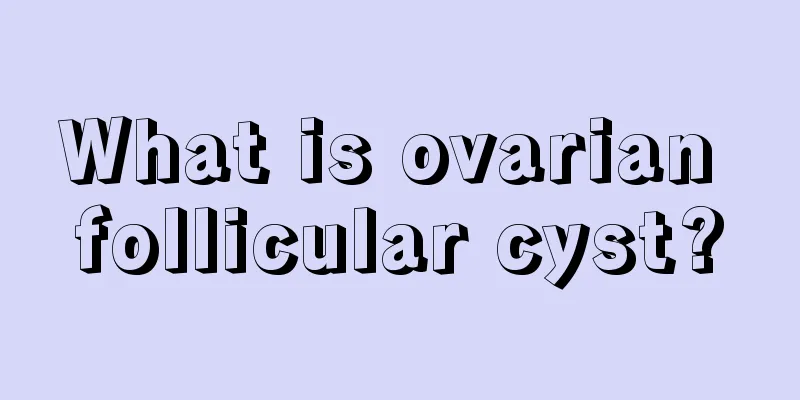What is ovarian follicular cyst?

|
Gynecological diseases are something that women are very concerned about nowadays. Regardless of whether they have gynecological diseases or not, many women will choose to go to the hospital for routine check-ups every year. However, despite this, there are still many people who do not pay much attention to gynecological diseases. Today I will introduce to you one type of gynecological disease - ovarian cysts, some symptoms and precautions. I believe it will be of great help to everyone's life. Non-neoplastic ovarian cysts Also known as non-neoplastic ovarian cysts, most of them are functional cysts of the ovaries, including follicular cysts, corpus luteum cysts, lutein cysts, inflammatory ovarian cysts, polycystic ovaries and endometriosis cysts (ie ovarian chocolate cysts). Most ovarian cysts are non-neoplastic cysts, and their diameter rarely exceeds 5 cm. These cysts are not tumors, and most of them are benign and can resolve on their own without surgery. However, if the cyst is large or progressively enlarges, or ruptures, it should also be surgically removed. That is to say, once an ovarian cyst is discovered, it should be determined as soon as possible whether it is a tumorous cyst or a non-tumorous cyst. The diagnosis can be made based on the speed of tumor growth, size, characteristics, and corresponding examinations, such as hysterosalpingography, intravenous pyelography, ultrasound diagnosis or abdominal tomography, magnetic resonance imaging, and even laparoscopy and laparotomy. If it is the former, early surgical resection is required regardless of whether it is currently malignant. Generally speaking, the most common ovarian cysts in women of childbearing age are functional ovarian cysts, such as follicular cysts, corpus luteum cysts, lutein cysts, and polycystic ovaries. These are caused by excessive physiological reactions due to endocrine dysfunction, insufficient secretion of luteinizing hormone, drug stimulation, etc. Patients generally do not feel any feeling or discomfort. A few may experience menstrual disorders, dysmenorrhea, infertility, etc., which are often discovered accidentally during medical examinations for other reasons. Inflammatory ovarian cysts are caused by inflammation of the fallopian tubes, which often spreads to the ovaries, forming inflammatory effusions and pus, and eventually forming ovarian cysts. To be precise, it should be an inflammatory mass rather than a true ovarian cyst. Ovarian endometriosis cyst, also known as ovarian chocolate cyst, is also a common ovarian cyst. It is caused by endometriosis spreading to the ovaries, forming cysts containing chocolate-like viscous fluid in the ovaries. Patients often experience progressively worsening dysmenorrhea, dyspareunia, infertility, and menstrual disorders. Ovarian cysts may present symptoms, but most are discovered during gynecological examinations. 1. Frequent urination, but without pain or urgency; or constipation. 2. I feel my lower abdomen is getting bigger and my pants waist is getting tighter. A lump may be felt in the lower abdomen, which is especially noticeable in the morning and disappears after urination. It can be seen that ovarian cyst is a general term for ovarian cystic masses. Its harm to the body and its treatment depend on its nature. Women over 30 should have a physical examination every year, including a gynecological examination, even if they do not feel any discomfort. If an ovarian cyst is found, further examination should be conducted to determine whether it is a functional cyst or a tumorous cyst so that different treatments can be adopted. Generally speaking, if the cyst is less than 5 cm in diameter and there is no evidence to suggest a tumor, it is most likely a functional cyst and can be followed up closely, that is, checked every 2-3 months and the intervals between checks adjusted based on the situation. If it shrinks or does not increase in size after 4-6 weeks, it is more likely to be a functional cyst. If the cyst continues to grow, especially if it is larger than 5 cm, or if there is sudden paroxysmal colic in the lower abdomen, it may be a tumor cyst or the cyst may have twisted or ruptured. It should be surgically explored to determine whether it is benign or malignant, and surgically removed if necessary. In fact, I think many diseases are caused by people not paying attention to their own bodies and having very irregular lifestyles. Here I would like to give you a piece of advice: you should take care of your own body and develop your own living habits. We can detect ovarian masses through gynecological examinations. |
<<: Why does vaginal pain occur when urinating?
>>: Can I have IVF if I have congenital fallopian tube malformation?
Recommend
What are the symptoms of lymph node enlargement in women?
The body's lymph is a relatively important pa...
Can you still take medicine after it’s expired? Don’t stockpile these 4 types of medicine at home!
Today, the editor looked through the circle of fr...
Will I still get acne on my face after pregnancy?
Pregnant women may also develop acne on their fac...
Why does hair loss occur after giving birth? How long does it take for hair loss to stop after giving birth?
We all know that after giving birth, women's ...
How long does it take for menstruation to come after lochia
It will take two or three months for normal menst...
How to practice vaginal blowing
We all know that when men and women have sexual r...
Is it normal to have your period early every month?
If female friends do not pay attention to their d...
Contraindications before and after injection of the nine-valent vaccine
After the cervical cancer vaccine came out, there...
Girls snore when they sleep at night
It is caused by the narrow position of the respir...
How to know endocrine disorders
The endocrine system is a very important system i...
How to care after breast augmentation injection?
Injection breast augmentation is a method of micr...
Treatment of adenomyosis in women
Female adenomyosis is undoubtedly a major focus o...
Why do pregnant women have headaches and sore feet?
We all know that pregnant women will experience s...
What is the situation of yellow leucorrhea with odor and itching?
Yellow leucorrhea with odor and itching generally...
Kidney disease is often caused by "delayed" treatment. If the body shows 5 symptoms, the kidneys are already seriously damaged.
Kidney disease, the general types of kidney disea...









